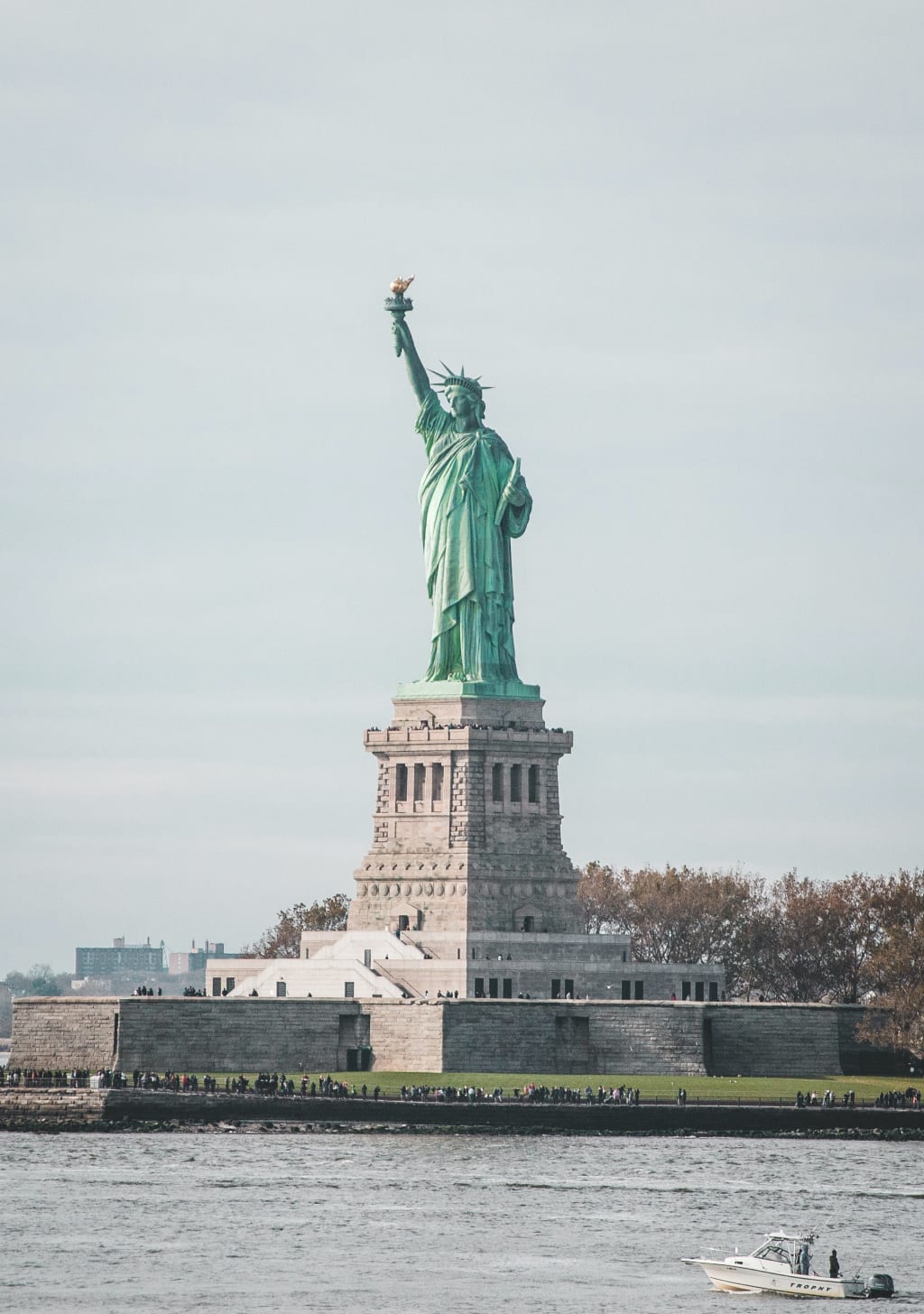
Statue Of Liberty New York
he Statue of Liberty is one of the most iconic landmarks of New York City and a symbol of freedom and democracy around the world. The statue, which stands on Liberty Island in New York Harbor, was a gift from France to the United States to commemorate the centennial of American independence in 1876.
The statue was designed by French sculptor Frederic Auguste Bartholdi and its construction was overseen by engineer Gustave Eiffel, who also designed the Eiffel Tower. The statue is made of copper and stands at 151 feet tall, or 305 feet if you include the pedestal it stands on. It depicts a woman holding a torch in her right hand and a tablet in her left hand with the date of the signing of the Declaration of Independence, July 4, 1776, inscribed on it.
The statue was constructed in France and then shipped to the United States in pieces. It was assembled on its pedestal on Liberty Island in 1886, and was officially dedicated on October 28 of that year in a ceremony presided over by President Grover Cleveland. The statue quickly became a symbol of freedom and hope for immigrants arriving in America, many of whom passed by it on their way to Ellis Island.
The statue has undergone several renovations and restorations over the years, including the addition of a new torch in 1986 to replace the original, which had become too fragile to be safely displayed. Today, the statue remains one of the most popular tourist attractions in New York City, with millions of visitors from around the world coming to see it each year.
In addition to its symbolic importance, the Statue of Liberty has also been used in popular culture as a backdrop for films, TV shows, and advertisements. Its image has been reproduced on everything from T-shirts to coffee mugs, and it remains an enduring symbol of the ideals of freedom and democracy that the United States was founded upon.
As mentioned earlier, the Statue of Liberty was a gift from France to the United States. The idea for the statue was first proposed by French historian Edouard de Laboulaye in 1865, as a way to honor the United States' commitment to democracy and freedom. At the time, France was still a monarchy, and de Laboulaye saw the United States as a shining example of what a democratic republic could be.
In 1871, de Laboulaye brought his idea to French sculptor Frederic Auguste Bartholdi, who had already gained fame for his larger-than-life sculptures. Bartholdi agreed to design the statue, which was to be modeled after the Roman goddess Libertas, who was the goddess of freedom.
Bartholdi spent years designing the statue and overseeing its construction in France. The statue was made of copper sheets, which were hammered into shape and then riveted together. The statue's frame was made of iron and designed by engineer Gustave Eiffel, who would later go on to design the Eiffel Tower.
The statue was completed in 1884 and shipped to the United States in crates. It took several months to reassemble the statue on its pedestal on Liberty Island, which was then called Bedloe's Island. The pedestal itself was a gift from the American people, who had raised money to pay for it.
The dedication of the statue took place on October 28, 1886, and was attended by thousands of people, including President Grover Cleveland. In his speech, Cleveland praised the statue as a symbol of freedom and democracy, saying, "We will not forget that Liberty has here made her home; nor shall her chosen altar be neglected."
The statue quickly became a popular tourist attraction, and it remains so to this day. Visitors can take a ferry from Manhattan to Liberty Island to see the statue up close, and many choose to climb to the top of the pedestal for a panoramic view of New York Harbor.
But the Statue of Liberty is more than just a tourist attraction. It has come to symbolize the ideals of freedom and democracy that the United States was founded upon. Its torch, held high above the harbor, has become a beacon of hope for millions of people around the world who have fled oppression and persecution in their home countries to seek a better life in America.
Perhaps nowhere is this more evident than at nearby Ellis Island, which was the main point of entry for immigrants to the United States from 1892 to 1954. Millions of immigrants passed by the Statue of Liberty on their way to Ellis Island, and many saw the statue as a symbol of the new life that awaited them in America.
In recent years, the Statue of Liberty has also become a symbol of America's struggle for civil rights and social justice. During the 1960s, civil rights activists often invoked the image of the statue as a way to highlight America's failure to live up to its own ideals of freedom and equality.
Today, the statue remains an important symbol of the United States and its commitment to freedom and democracy. Its image is reproduced on everything from postage stamps to T-shirts, and it is often used as a backdrop for political rallies and speeches. In 1986, the statue was declared a UNESCO World Heritage Site, recognizing its importance as a cultural and historical landmark.
In conclusion, the Statue of Liberty is not just a sculpture, but a powerful symbol of America's commitment to freedom and democracy. It has come to represent the hopes and dreams of millions of people around the world who seek a better life, and it continues to inspire us to strive for a more just
In addition to its symbolic significance, the Statue of Liberty has also played a role in American history in more practical ways. During World War II, the statue was used as a lookout post by the United States Army Air Corps, who used the statue's torch as a navigational aid.
The statue has also undergone several renovations and restorations over the years. In the 1980s, the statue's original torch was replaced with a new one made of copper and covered in 24-karat gold leaf. The original torch was found to be too fragile to be safely displayed, and it is now on display in the statue's museum.
More recently, the statue underwent a major renovation project called the Statue of Liberty-Ellis Island Foundation Restoration, which began in 1984 and lasted until 2000. The project was funded by private donations and involved repairing and replacing many of the statue's components, including its torch, crown, and pedestal.
Today, visitors to the Statue of Liberty can explore its interior, which includes a museum that tells the story of the statue's history and significance. Visitors can also climb to the top of the pedestal for a view of the harbor, or take an elevator to the top of the statue's crown for an even more spectacular view.
The statue remains an important symbol of freedom and democracy not just in the United States, but around the world. Its image has been reproduced on countless items, from posters to postcards, and it is often used as a symbol of hope and inspiration. In 2017, the statue was used as a backdrop for the Women's March, a political protest that drew hundreds of thousands of people to Washington, D.C., and cities around the world.
Despite its enduring popularity, the statue has also faced criticism over the years. Some have argued that it represents a false ideal of freedom, given the United States' history of racism, inequality, and imperialism. Others have criticized the statue's use in political rhetoric, arguing that it has been co-opted by politicians to justify policies that are at odds with its original message of freedom and democracy.
Regardless of its critics, the Statue of Liberty remains an important symbol of hope and inspiration, both for Americans and for people around the world. Its message of freedom and democracy has resonated for over a century, and it continues to inspire us to strive for a better, more just world.
About the Creator
world pen
Writing has been my passion since I was 20 years old. I love creating stories from fiction, poetry, fanfiction.I enjoy writing all types I would love to become a creative writing teacher and leave the world inspiring minds.
Enjoyed the story? Support the Creator.
Subscribe for free to receive all their stories in your feed. You could also pledge your support or give them a one-off tip, letting them know you appreciate their work.






Comments
There are no comments for this story
Be the first to respond and start the conversation.